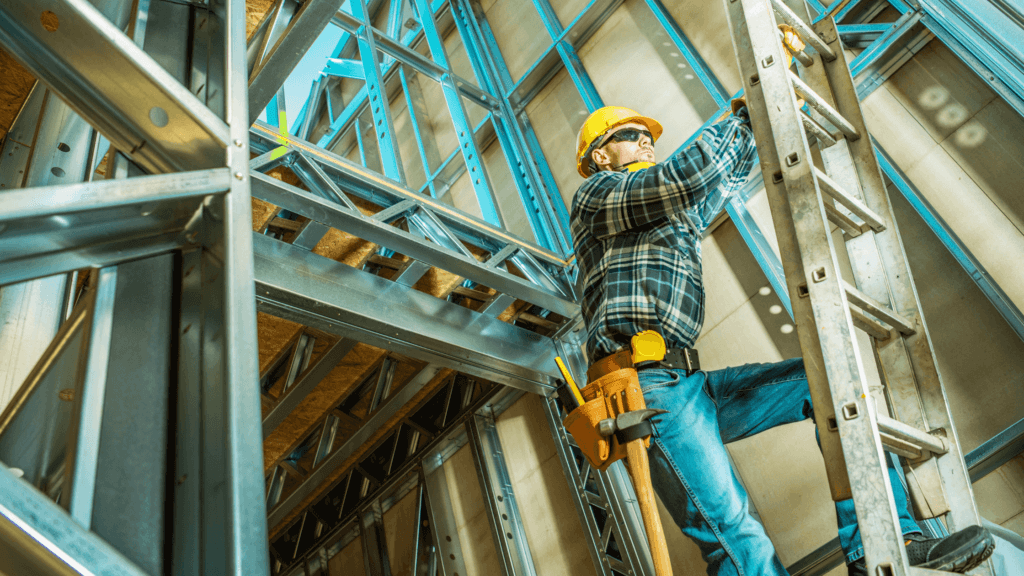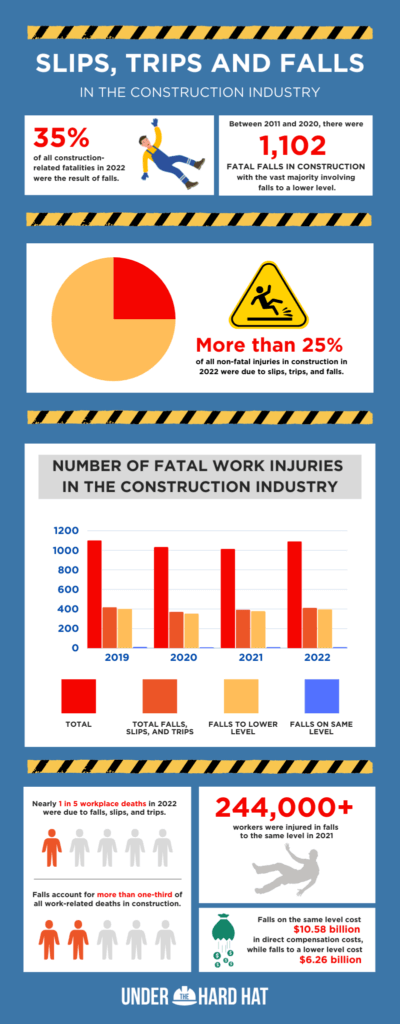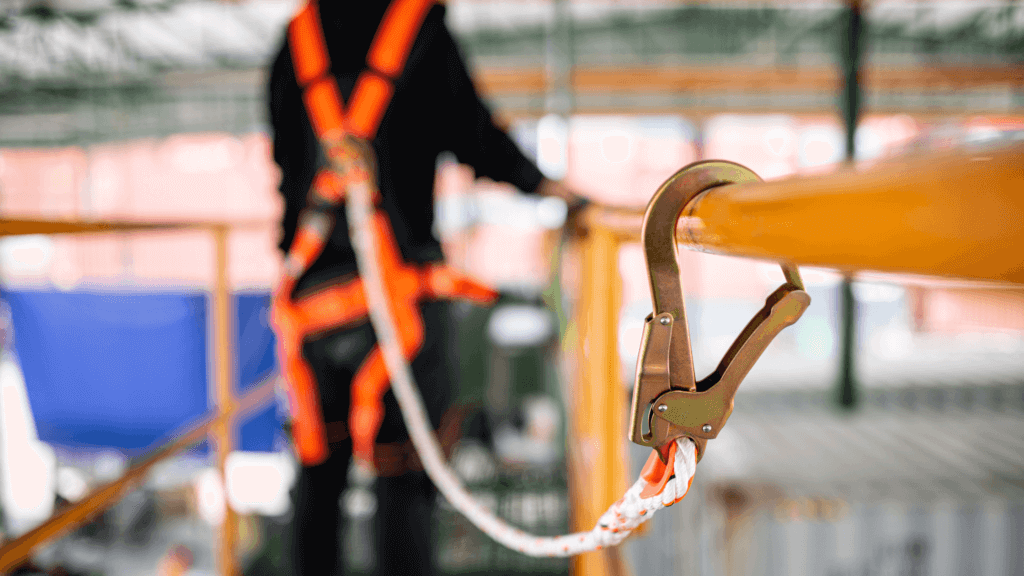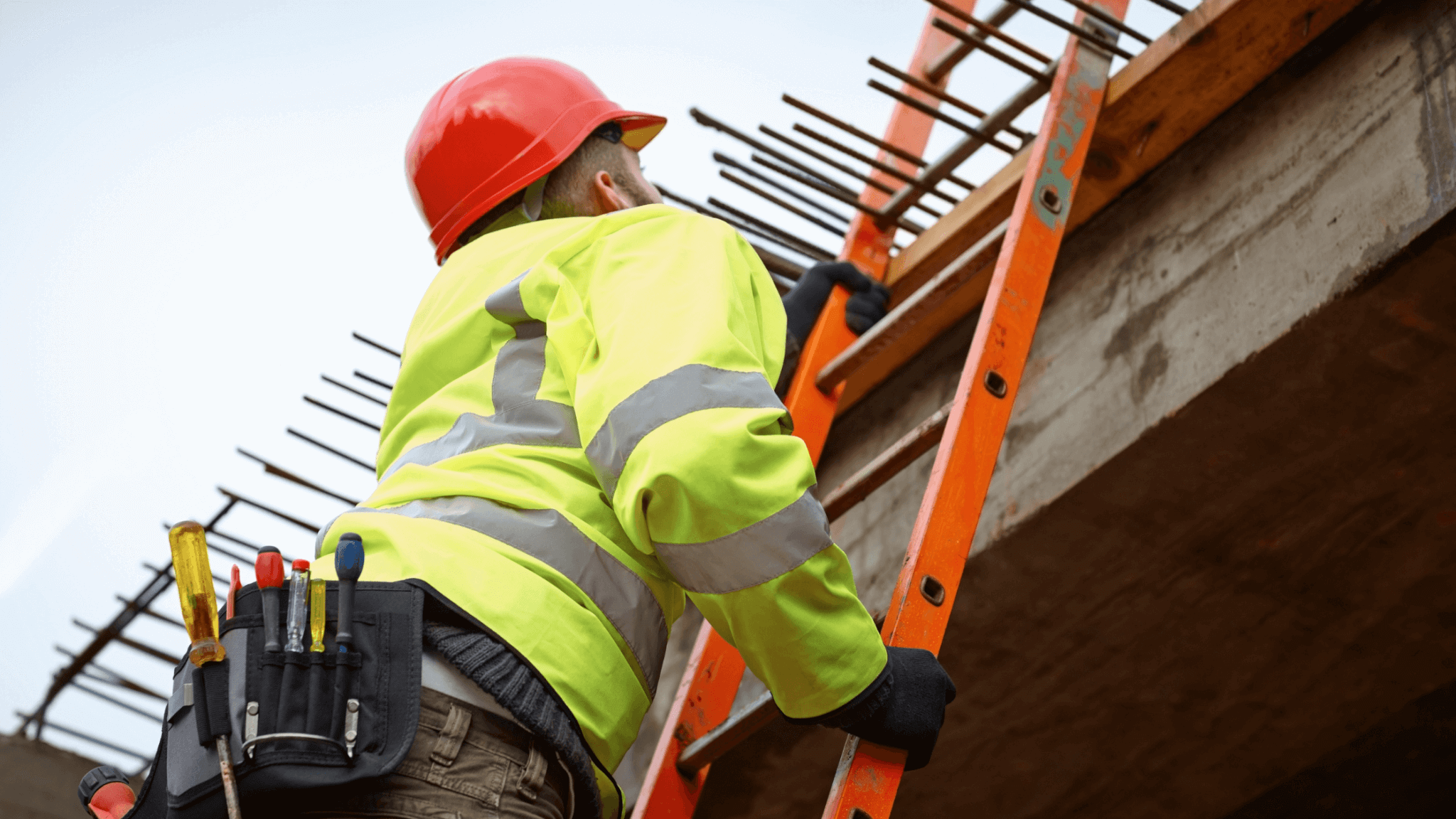When it comes to construction, safety isn’t just a priority—it’s a necessity. Slips, trips, and falls are some of the most common and dangerous incidents on any job site, leading to severe injuries, lost workdays, and sometimes worse. Proper footwear, training, and awareness are key to preventing accidents and ensuring job site safety.
According to the U.S. Bureau of Labor Statistics, falls accounted for over 35% of all construction-related fatalities in 2022. But why are these accidents so frequent in the construction industry? The odds of a misstep are high with uneven surfaces, cluttered spaces, and unpredictable weather.
Keeping your crew safe isn’t just about avoiding accidents—it’s about creating a productive and positive work environment where everyone can feel secure.
Slips, trips, and falls

Slips, trips, and falls might seem straightforward, but each incident has causes and risks. Let’s break them down:
- Slips occur when there isn’t enough traction between your foot and your walking surface. Slips can happen on wet or oily floors, uneven ground, or debris scattered across the site. For example, a worker might step on a patch of spilled oil, lose their footing, and fall.
- Trips happen when your foot strikes an object or uneven surface, causing you to lose balance. On a construction site, this can be caused by things like tangled extension cords, tools left in pathways, or uneven ground. Imagine rushing from one end of the site to the other and tripping over a stray piece of rebar.
- Falls are typically the result of slips or trips but can also occur independently, especially from heights. Workers often operate at various elevations, whether on scaffolding, ladders, or rooftops. A simple misstep on an improperly secured ladder could send someone tumbling down, resulting in serious injury.
These accidents can happen in the blink of an eye, but the consequences are often severe, so understanding their causes is crucial for preventing them.
Slips, trips, and falls in construction
Slips, trips, and falls are a big issue in the construction industry, accounting for a significant portion of all workplace injuries. The numbers don’t lie—these incidents occur more frequently than expected, making construction sites particularly hazardous if proper precautions aren’t in place.
According to the U.S. Bureau of Labor Statistics (BLS), falls are the leading cause of fatalities in the construction industry, responsible for over 35% of all construction-related deaths in 2022. This isn’t just about fatal accidents either. Slips, trips, and falls also result in numerous non-fatal injuries, leading to thousands of lost workdays. For instance, the CPWR’s Data Dashboard reports that between 2011 and 2020, there were 1,102 fatal falls in construction, and falls to a lower level accounted for the vast majority of these.

Moreover, slips, trips, and falls were responsible for more than 25% of all non-fatal injuries in construction in 2022, underscoring the need for preventative measures.
The impact on workers and employers alike is immense. Injuries from slips, trips, and falls can lead to extended periods away from work. In fact, in 2022, construction workers injured from falls had an average of 21 days away from work, according to the BLS. This affects the workers’ livelihoods and creates operational challenges for companies struggling to fill those gaps.
The data paints a worrying picture, but these statistics also highlight areas for improvement.
The danger of slips, trips, and falls
The danger of slips, trips, and falls extends beyond the immediate physical harm—they can have serious, life-altering consequences, both in the short and long term:
Physical injuries
Slips, trips, and falls are responsible for a wide range of injuries on construction sites. These can range from sprains and fractures to more severe cases like broken bones, concussions, and spinal injuries. A fall from a ladder, for instance, can lead to multiple broken limbs or even traumatic brain injuries. According to the National Safety Council, over 244,000 workers were injured in falls at the same level in 2021, many in the construction industry.
Fatalities
Falls, in particular, are the most deadly of the three. In construction, falls account for more than one-third of all work-related deaths. A misstep off a scaffold or rooftop can have fatal consequences, as seen in the statistics from the U.S. Bureau of Labor Statistics, which reports that nearly 1 in 5 workplace deaths were the result of falls, slips, and trips. These deaths don’t just affect workers—they leave families, friends, and colleagues devastated.
Lost workdays and productivity
When an injury occurs, it often leads to significant time away from work. This lost time directly impacts worker productivity and strains the rest of the team to cover shifts, leading to project delays and increased costs.
Compensation and medical costs
The financial toll is also heavy. Workers’ compensation claims for falls can cost companies thousands of dollars per incident. According to Liberty Mutual’s 2021 Workplace Safety Index, falls on the same level cost U.S. businesses $10.58 billion in direct compensation costs, while falls to a lower level accounted for another $6.26 billion. These figures only cover the direct costs; when you factor in indirect costs like training replacements, project delays, and legal fees, the financial burden is even higher.
Preventing slips, trips, and falls in construction

Here’s the good news: many of these accidents are entirely preventable with the proper measures. Let’s look at some practical steps you can take to keep your team safe and minimize accidents.
Proper footwear
One of the simplest and most effective ways to prevent slips, trips, and falls is by ensuring workers have the right footwear. Non-slip, sturdy boots with proper tread can make a huge difference in gaining traction on slippery or uneven surfaces.
Look for boots that meet OSHA standards and are designed for construction environments. In addition to non-slip soles, protective features like steel toes or reinforced ankles offer extra safety from other site hazards like falling tools or heavy materials. Footwear may seem like a small detail, but it can be a literal lifesaver on the job.
Awareness
Many accidents happen simply because hazards are overlooked or not immediately visible. That’s why raising awareness on-site is critical to keeping everyone safe. Encourage workers to stay vigilant by being aware of their surroundings and reporting potential dangers when they spot them.
Posting safety reminders in high-traffic areas and holding regular toolbox talks on slip and trip hazards help everyone on-site remember these risks. Workers tuned into their surroundings are less likely to fall victim to avoidable accidents.
Training around hazards
Proper training is crucial for reducing the risk of slips, trips, and falls in construction. Workers need to understand how to safely navigate the unique dangers of construction sites, from uneven floors to weather conditions.
Regular safety training programs can teach employees to identify hazards, understand the proper use of safety gear, and follow best practices when working from heights or around wet surfaces. Comprehensive training should also include using fall protection equipment, like harnesses and guardrails, to prevent falls from ladders, scaffolding, and rooftops. When workers know how to handle hazards, the risk of injury drops significantly.
Additional strategies
Beyond footwear, awareness, and training, other key strategies can help reduce the likelihood of slips, trips, and falls:
- Site cleanliness: Keeping work areas clean and free of clutter is essential. Ensure pathways are clear of debris, tools, and equipment that could cause a trip.
- Hazard identification: Conduct regular inspections to spot slip and trip hazards like loose flooring, spills, or cables strewn across the floor.
- Floor marking: Use brightly colored floor markings to indicate hazardous areas or places where caution is needed, such as near open pits or uneven surfaces.
The bottom line
Preventing slips, trips, and falls in construction isn’t just about following regulations but creating a safer, more productive work environment. The good news is that these incidents are largely preventable. When safety is prioritized, lives are saved, costs are reduced, and overall productivity is improved. In the end, a safe site is a successful one—it all starts with being proactive.



